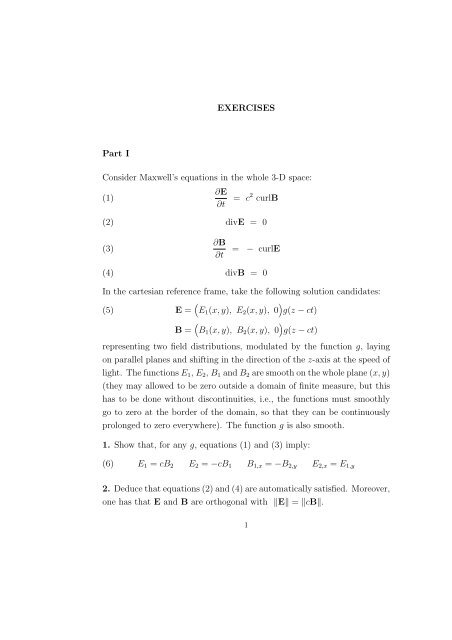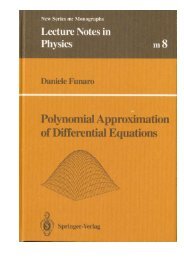EXERCISES Part I Consider Maxwell's equations in the whole 3-D ...
EXERCISES Part I Consider Maxwell's equations in the whole 3-D ...
EXERCISES Part I Consider Maxwell's equations in the whole 3-D ...
You also want an ePaper? Increase the reach of your titles
YUMPU automatically turns print PDFs into web optimized ePapers that Google loves.
<strong>Part</strong> I<br />
<strong>EXERCISES</strong><br />
<strong>Consider</strong> Maxwell’s <strong>equations</strong> <strong>in</strong> <strong>the</strong> <strong>whole</strong> 3-D space:<br />
(1)<br />
∂E<br />
∂t = c2 curlB<br />
(2) divE = 0<br />
(3)<br />
∂B<br />
∂t<br />
= − curlE<br />
(4) divB = 0<br />
In <strong>the</strong> cartesian reference frame, take <strong>the</strong> follow<strong>in</strong>g solution candidates:<br />
(5) E = <br />
E1(x,y), E2(x,y), 0 <br />
g(z − ct)<br />
B = <br />
B1(x,y), B2(x,y), 0 <br />
g(z − ct)<br />
represent<strong>in</strong>g two field distributions, modulated by <strong>the</strong> function g, lay<strong>in</strong>g<br />
on parallel planes and shift<strong>in</strong>g <strong>in</strong> <strong>the</strong> direction of <strong>the</strong> z-axis at <strong>the</strong> speed of<br />
light. The functions E1, E2, B1 and B2 are smooth on <strong>the</strong> <strong>whole</strong> plane (x,y)<br />
(<strong>the</strong>y may allowed to be zero outside a doma<strong>in</strong> of f<strong>in</strong>ite measure, but this<br />
has to be done without discont<strong>in</strong>uities, i.e., <strong>the</strong> functions must smoothly<br />
go to zero at <strong>the</strong> border of <strong>the</strong> doma<strong>in</strong>, so that <strong>the</strong>y can be cont<strong>in</strong>uously<br />
prolonged to zero everywhere). The function g is also smooth.<br />
1. Show that, for any g, <strong>equations</strong> (1) and (3) imply:<br />
(6) E1 = cB2 E2 = −cB1 B1,x = −B2,y E2,x = E1,y<br />
2. Deduce that <strong>equations</strong> (2) and (4) are automatically satisfied. Moreover,<br />
one has that E and B are orthogonal with E = cB.<br />
1
3. Deduce that <strong>the</strong> functions E1 − iE2 and B1 − iB2, where i is <strong>the</strong><br />
imag<strong>in</strong>ary unit, are holomorphic (entire) on <strong>the</strong> <strong>whole</strong> complex plane x+iy<br />
(see, for <strong>in</strong>stance [1]).<br />
4. Use <strong>the</strong> Liouville’s <strong>the</strong>orem: if an entire holomorphic function is bounded,<br />
<strong>the</strong>n it is a constant, to entail that <strong>the</strong>re are no bounded cont<strong>in</strong>uous elec-<br />
tromagnetic fields of <strong>the</strong> form (5), hav<strong>in</strong>g f<strong>in</strong>ite energy, solv<strong>in</strong>g <strong>the</strong> <strong>whole</strong><br />
set of Maxwell’s <strong>equations</strong>, with <strong>the</strong> exception of E = 0 and B = 0.<br />
5. Try to generalize <strong>the</strong> sett<strong>in</strong>g <strong>in</strong> (5) by <strong>in</strong>troduc<strong>in</strong>g <strong>the</strong> third components<br />
E3(x,y) and B3(x,y). By analyz<strong>in</strong>g <strong>the</strong> third component of (1) and (2),<br />
show, us<strong>in</strong>g separation of variables arguments, that g must be an exponen-<br />
tial. Therefore, if g is zero <strong>in</strong> one po<strong>in</strong>t (<strong>the</strong> ‘head’ of <strong>the</strong> advanc<strong>in</strong>g front),<br />
<strong>the</strong>n g must be zero everywhere.<br />
6. Try to generalize <strong>the</strong> sett<strong>in</strong>g <strong>in</strong> (5) by us<strong>in</strong>g several functions gi, i =<br />
1, 2, 3, 4 as follows:<br />
(7) E = <br />
E1(x,y)g1(z − ct), E2(x,y)g2(z − ct), 0 <br />
B = <br />
B1(x,y)g3(z − ct), B2(x,y)g4(z − ct), 0 <br />
Prove that g1 = g4 and g2 = g3. Recover (6) and <strong>the</strong>n proceed as <strong>in</strong><br />
po<strong>in</strong>t 1.<br />
Moral: The only possible solutions of Maxwell’s <strong>equations</strong> <strong>in</strong> vacuum,<br />
hav<strong>in</strong>g bounded electromagnetic fields lay<strong>in</strong>g on flat fronts, are ei<strong>the</strong>r iden-<br />
tically zero or have <strong>in</strong>f<strong>in</strong>ite energy. Note that solutions may exist if we<br />
assume that E and B do not belong to <strong>the</strong> tangent plane of <strong>the</strong> advanc<strong>in</strong>g<br />
front. In this situation, however, <strong>the</strong> Poynt<strong>in</strong>g vector E × B, <strong>in</strong>dicat<strong>in</strong>g<br />
<strong>the</strong> direction of <strong>the</strong> energy flow, is not l<strong>in</strong>ed up with <strong>the</strong> direction of move-<br />
ment. These solutions, display<strong>in</strong>g a complicate evolutive behavior, are not<br />
obta<strong>in</strong>able by separat<strong>in</strong>g time and space variables as we did <strong>in</strong> (5).<br />
2
<strong>Part</strong> II<br />
Transform <strong>the</strong> <strong>equations</strong> (1)-(2)-(3)-(4) <strong>in</strong> spherical coord<strong>in</strong>ates (r,θ,φ)<br />
and take <strong>the</strong> follow<strong>in</strong>g fields, distributed on <strong>the</strong> tangent planes of spherical<br />
wave-fronts:<br />
(8) E = 1<br />
0, E2(θ,φ), E3(θ,φ)<br />
r<br />
<br />
g(r − ct)<br />
B = 1<br />
0, B2(θ,φ), B3(θ,φ)<br />
r<br />
<br />
g(r − ct)<br />
With this choice, <strong>the</strong> energy density |E| 2 + |cB| 2 rema<strong>in</strong>s constant when<br />
<strong>in</strong>tegrated over any spherical surface.<br />
7. Show that:<br />
(9) E3 = −cB2 E2 = cB3 (B2 s<strong>in</strong> θ)θ = −B3,φ (E3 s<strong>in</strong> θ)θ = E2,φ<br />
Hence, <strong>the</strong> complex functions E2 − iE3 s<strong>in</strong> θ and B2 − iB3 s<strong>in</strong> θ are<br />
holomorphic on <strong>the</strong> Riemann sphere. Deduce that E and B are bounded<br />
if and only if <strong>the</strong>y are zero. Similarly, deduce all <strong>the</strong> o<strong>the</strong>r consequences of<br />
<strong>the</strong> previous exercise.<br />
Moral: The only possible solutions of Maxwell’s <strong>equations</strong> <strong>in</strong> vacuum,<br />
hav<strong>in</strong>g bounded electromagnetic fields lay<strong>in</strong>g on tangent planes of spheri-<br />
cal fronts are identically zero. The same arguments can be applied to any<br />
closed, bounded, compact, oriented surface. Non trivial solutions (for ex-<br />
ample, <strong>the</strong> Hertz solutions) are <strong>in</strong>stead possible by allow<strong>in</strong>g <strong>the</strong> fields to<br />
have radial components E1 and B1. In this way, however, <strong>the</strong> Poynt<strong>in</strong>g<br />
vector E × B is not aligned with <strong>the</strong> direction of movement.<br />
3
<strong>Part</strong> III<br />
Replace Maxwell’s <strong>equations</strong> with <strong>the</strong> new system:<br />
(10)<br />
(11)<br />
∂E<br />
∂t = c2 curlB − (divE)V<br />
∂B<br />
∂t<br />
= − curlE<br />
(12) divB = 0<br />
8. Prove that, under <strong>the</strong> sole condition B1,x+B2,y = 0, <strong>the</strong> fields proposed<br />
<strong>in</strong> (5) are always solutions, when V = (0, 0,c). In addition, one has:<br />
E + V × B = 0.<br />
9. Prove that, under <strong>the</strong> sole condition (B2 s<strong>in</strong> θ)θ + B3,φ = 0, <strong>the</strong> fields<br />
proposed <strong>in</strong> (8) are always solutions, when V = (c, 0, 0). In addition, one<br />
has: E + V × B = 0.<br />
Moral: With <strong>the</strong> new model <strong>equations</strong> we have an extended range of<br />
solutions, not available <strong>in</strong> <strong>the</strong> Maxwellian case. In particular, this <strong>in</strong>cludes<br />
wave-packets of almost any form, both from <strong>the</strong> viewpo<strong>in</strong>t of <strong>the</strong> shape of<br />
<strong>the</strong> wave-fronts and <strong>the</strong> <strong>in</strong>formation written on <strong>the</strong>m. These wave-packets<br />
travel unperturbed at speed c, along <strong>the</strong> direction of <strong>the</strong> vector V. They<br />
perfectly follow <strong>the</strong> rules of geometrical optics.<br />
[1] J. B. Conway, Functions of One Complex Variable, Second Edition,<br />
Spr<strong>in</strong>ger, 1978.<br />
4
















